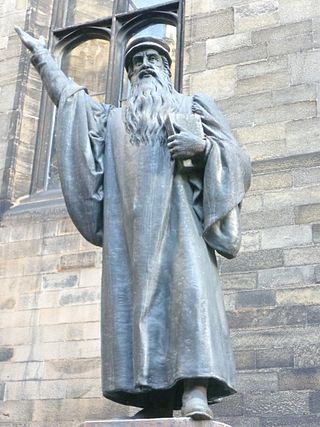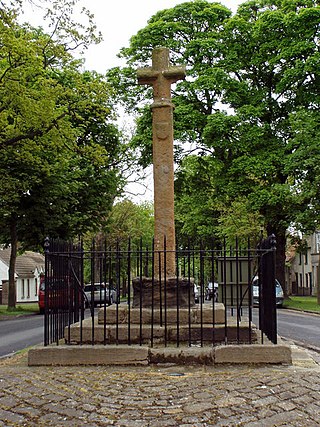Related Research Articles

John Knox was a Scottish minister, Reformed theologian, and writer who was a leader of the country's Reformation. He was the founder of the Presbyterian Church of Scotland.
The Treaty of Edinburgh was a treaty drawn up on 5 July 1560 between the Commissioners of Queen Elizabeth I of England with the assent of the Scottish Lords of the Congregation, and the French representatives of King Francis II of France to formally conclude the siege of Leith and replace the Auld Alliance with France with a new Anglo-Scottish accord, while maintaining the peace between England and France agreed by the Treaty of Cateau-Cambrésis.
There was no concept of "British history" in the 1500s, except that the word "British" was used to refer to the ancient Britons and the Welsh.

James Hamilton, 3rd Earl of Arran (1537–1609) was a Scottish nobleman and soldier who opposed the French-dominated regency during the Scottish Reformation. He was the eldest son of James Hamilton, Duke of Châtellerault, sometime regent of Scotland. He was of royal descent, and at times was third or fourth in succession to the Scottish crown; several royal marriages were proposed for him, but he eventually never married. He went to France with Mary, Queen of Scots, where he commanded the Scots Guards. After returning to Scotland, he became a leader of the Protestant party against Mary and her French supporters. However, he went insane in 1562 and was confined for the rest of his life.

The Lords of the Congregation, originally styling themselves the Faithful, were a group of Protestant Scottish nobles who in the mid-16th century favoured a reformation of the Catholic church according to Protestant principles and a Scottish-English alliance.
John Willock was a Scottish reformer. He appears to have been a friar of the Franciscan House at Ayr. Having joined the party of reform before 1541, he fled for his life to England. There he became noted as a zealous and taking preacher. This led to his arrest for heresy under an Act of Henry VIII., "for abolishing diversity of opinion" in matters of religion. He was found guilty of preaching against purgatory, holy water, priestly confession, and prayer to the saints, and of holding that priests might lawfully be married, he was for some time confined in the Fleet prison. After the accession of Edward VI he was chaplain to Henry, Duke of Suffolk, who had married King Henry's niece, and is best known as the father of Lady Jane Grey. He preached for a time in London, in St Katherine's Church, when both he and John Knox, his fast friend, were granted general license to preach anywhere in England. Henry, Earl of Huntingdon, presented him to the rectory of Loughborough in Leicestershire, a living which he continued to hold during King Edward's reign, and again during that of Queen Elizabeth for the rest of his life. Thus in his later years he was in the unique position of being at the same time a parish minister in both England and Scotland. When Mary Tudor came to the English throne in 1553, Willock fled to Embden, in the Protestant Duchy of Friesland. There he practised as a physician with much success, and rose to some eminence. In 1555, and again in 1556, the Duchess Anne of Friesland sent him to Scotland as her Commissioner on matters of trade. In 1558 he returned home, and preached for some time in Dundee, with much acceptance among the friends of reform. In 1559, when John Knox had to leave Edinburgh in peril of his life, Willook took his place as the evangelist of the Reformation. It was then that he conducted in St Giles what is believed to have been the earliest public celebration of the Holy Communion in Scotland after the reformed ritual. In 1560, when Queen Mary of Guise lay dying, the Earls of Argyll and Moray, and other Lords of the Congregation advised her to "send for a godly, learned man of whom she might receive instruction"; and Willock was chosen to minister to her, which he faithfully did. That same year he was made Superintendent of Glasgow and the West. He was also one of the six Johns entrusted with the drawing up of the First Book of Discipline, the others being John Knox, John Winram, John Spottiswood, John Douglas, and John Row. Sometime in that year he went to England, and brought home his wife, Katherine Picknavell, an English lady. He was chosen Moderator of the General Assembly in 1563, 1564, 1565, and 1568. In 1565 Queen Mary endeavoured to put a stop to his activity by having him imprisoned in Dumbarton Castle; but the Reformers were now too strong for her, and she had to depart from her purpose.

The Scots Confession is a Confession of Faith written in 1560 by six leaders of the Protestant Reformation in Scotland. The text of the Confession was the first subordinate standard for the Protestant church in Scotland. Along with the Book of Discipline and the Book of Common Order, this is considered to be a formational document for the Church of Scotland during the time.

Robert Pont (1529–1606) was a Church of Scotland minister, judge and reformer. He was a church minister and commissioner and a Senator of the College of Justice.
The Book of Discipline refers to two works regulative of ecclesiastical order in the Church of Scotland, known as The First Book of Discipline (1560) and The Second Book of Discipline (1578), drawn up and printed in the Scottish Reformation. The first was drafted by a committee of "six Johns", including leading reformer John Knox. It set out a system of Presbyterian polity on the Geneva model, but the lack of funds meant its programme of clerical organisation and education was largely abandoned. The second book was adopted after the forced abdication of Mary Queen of Scots and was much more clearly Presbyterian in outlook. It placed church supervision fully in the hands of groups of elected church leaders in presbyteries.

The Scottish Reformation was the process whereby Scotland broke away from the Catholic Church, and established the Protestant Church of Scotland.. It forms part of the wider European 16th century Protestant Reformation.
The history of the Scottish Episcopal Church is traced by the church to ancient times. The Church today is a Christian denomination in Scotland and a member of the Anglican Communion. It has enjoyed a distinct identity and is neither Roman nor English. It is therefore not a Daughter Church in the Anglican communion.

The Treaty of Berwick was negotiated on 27 February 1560 at Berwick-upon-Tweed. It was an agreement made by the representative of Queen Elizabeth I of England, the Duke of Norfolk, and the group of Scottish nobles known as the Scottish Lords of the Congregation. The purpose was to agree the terms under which an English fleet and army would come to Scotland to expel the French troops who were defending the Regency of Mary of Guise. The Lords were trying both to expel the French and to effect the Scottish Reformation, and this led to rioting and armed conflict.
Sir James MacGill, Lord Rankeillor of Nether Rankeillour, was a Scottish courtier and Senator of the College of Justice.

The Articles of Leith were the terms of truce drawn up between the Protestant Lords of the Congregation and Mary of Guise, Regent of Scotland and signed on 25 July 1559. This negotiation was a step in the conflict that led to the Scottish Reformation. Although its immediate effect was the withdrawal of Protestant forces from Edinburgh, subsequent disputes over the content and observance of the treaty fuelled the crisis in Scotland.

John Craig was a Reformer, and colleague of John Knox. Originally a Dominican, he became a Church of Scotland minister with significant extra responsibilities and played an influential part in the Scottish Reformation.

John Cockburn, laird of Ormiston, East Lothian, Scotland, was an early supporter of the Scottish Reformation. He was the eldest son of William Cockburn of Ormiston and Janet Somerville. John was usually called "Ormiston." During his lifetime there was also a laird of Ormiston in Teviotdale near Eckford, a member of the rival Hepburn family.
John Row (c1525–1580), was a Scottish reformer, born around 1526 near Dunblane. He was educated at the Grammar School of Stirling and St Leonard's College, St Andrews, where he matriculated in 1544. After graduating with an M.A. he studied Canon Law and practised as an advocate in the Consistory Court of St Andrews. In 1550, he was appointed agent for the Scottish clergy at Rome, where he remained seven or eight years. He was awarded Licentiate of Laws, and LL.D. Padua. The fame of his talents and learning led to his intimacy with Pope Paul IV and some of the cardinals, and would probably have led to his promotion ; but owing to ill-health he was compelled to return to Scotland, when he was appointed nuncio to investigate the causes of the Reformation and to devise means for checking its progress. He reached Eyemouth on 29 September 1558, but finding himself unable to fulfil his injunctions, returned to Rome before 11 May 1559. After a short residence there, he came back by persuasion of James, Prior of St Andrews, afterwards Earl of Moray, and having seen the falsehood and imposition of a pretended miracle at St Allaret's Chapel, Musselburgh, he joined the Reformers. He was admitted to Kennoway in April 1560, before the Reformation was fully established. John Row was one of six ministers appointed by the Lords of the Congregation for "writing in a book their judgments touching the Reformation of religion." These appeared in the Confession of Faith and First Book of Discipline. He was translated to Perth 17 July, and admitted before 20 December 1560. He was appointed by the General Assembly, 10 July 1568, to visit Galloway. He was styled Commissioner of Nithsdale and Galloway, March 1570 and elected Moderator of the General Assembly 21 July and 25 December 1567, 24 April 1576, and 11 June 1578. He died on 16 October 1580, at which time he held the vicarages of Twynholm and Terregles in Galloway. He was regarded as "a cautious and prudent reformer, of moderate views, benevolent disposition, and amiable and winning manners, a wise and grave father, of good literature according to the time." He was skilled in the original languages of Scripture, and did much towards building up the Reformed Church in Scotland. He was married in 1560 to Margaret, second daughter of John Beaton of Balfour.
Sir John Wishart of Pitarrow was a Scottish lawyer, courtier, comptroller of the exchequer, and rebel.
John Black OP was a Roman Catholic Dominican serving as a recently named post-Tridentine special preacher, and confessor, to Mary, Queen of Scots when he was murdered on the same night as David Rizzio in Edinburgh.
Events from the year 1560 in the Kingdom of Scotland.
References
- ↑ "Statute Law: Confession of Faith Ratification Act 1560" . Retrieved 18 August 2007.
- ↑ "Statute Law: Papal Jurisdiction Act 1560" . Retrieved 18 August 2007.
- ↑ "Statute Law: General Assembly Act 1592" . Retrieved 18 August 2007.
- ↑ CSP Scotland, vol. 1 (1898), 462: Acts of the Parliaments of Scotland, vol. 2 (1814), 526-534.
- ↑ CSP Scotland, vol. 1, (1898) 465, 466-467: Acts of the Parliaments of Scotland, vol. 2, (1814), 605-606.
- ↑ Calendar State Papers Scotland, vol. 1, (1898), 473-474.
- ↑ Calendar of State Papers relating to Scotland, vol. 1 (1898), 456-459, Randolph to Cecill.